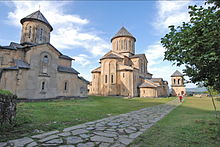
Back Гелаҭтәи аберҭыԥ Abkhazian دير غيلاتي Arabic Gelati monastırı Azerbaijani Гелати монастыры Bashkir Гелацкі манастыр Byelorussian Гелацкі манастыр BE-X-OLD Monestir de Guelati Catalan Klášter Gelati Czech Gelati German Μοναστήρι του Γκελάτι Greek
| Gelati Monastery | |
|---|---|
გელათის მონასტერი | |
 The monastic complex of Gelati | |
| Religion | |
| Affiliation | Georgian Orthodox Church |
| Location | |
| Location | Kutaisi, Imereti, Georgia |
| Geographic coordinates | 42°17′41″N 42°46′05″E / 42.29472°N 42.76806°E |
| Architecture | |
| Type | Monastery |
| Style | Georgian |
| Founder | David IV of Georgia ("David the Builder") |
| Completed | Church of the Virgin, 1106; Churches of St. George and St. Nicholas, 13th century |
| Official name: Gelati Monastery | |
| Type | Cultural |
| Criteria | iv |
| Designated | 1994 (18th session) |
| Reference no. | 710 |
| Region | Europe and North America[1] |
| Official name: Gelati Monastery | |
| Designated | November 7, 2006 |
| Reference no. | 875 |
| Item Number in Cultural Heritage Portal | 8550 |
| Date of entry in the registry | October 3, 2007 |
Gelati (Georgian: გელათის მონასტერი) is a medieval monastic complex near Kutaisi in the Imereti region of western Georgia. One of the first monasteries in Georgia,[2] it was founded in 1106 by King David IV of Georgia as a monastic and educational center.
The monastery is an exemplar of the Georgian Golden Age and a gold aesthetic is employed in the paintings and buildings.[3] It was built to celebrate the Orthodox Christian faith in Georgia;[4] some murals found inside the Gelati Monastery church date back to the 12th century.[5] The monastery was inscribed as a UNESCO World Heritage Site in 1994 because of its outstanding architecture and its importance as an educational and scientific center in medieval Georgia.[6]
- ^ Europe and North America, UNESCO, 2021
- ^ Kaufhold, Hubert (2011). "Gelati Monastery". Religion Past and Present. doi:10.1163/1877-5888_rpp_SIM_08287.
- ^ Centre, U.W.H. (n.d.). Gelati Monastery, Georgia, removed from UNESCO’s List of World Heritage in Danger. [online] UNESCO World Heritage Centre. Available at: https://whc.unesco.org/en/news/1692
- ^ Calma, Dragos (2020). Reading Proclus and the Book of Causes, Volume 2. Dublin: University College Dublin.
- ^ "World Heritage Site". 1997–2020.
- ^ Centre, UNESCO World Heritage. "Gelati Monastery". UNESCO World Heritage Centre. Retrieved 2021-11-27.
© MMXXIII Rich X Search. We shall prevail. All rights reserved. Rich X Search

